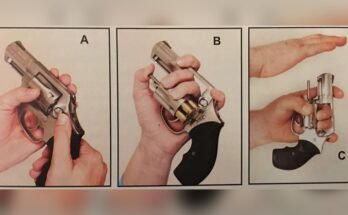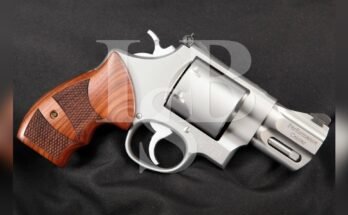Have you ever wondered what makes a double-action revolver different from other firearms? Understanding how this type of revolver works can give you a clearer picture of its power, speed, and reliability.
Whether you’re curious about firearms, considering a purchase, or just want to know more, this guide will break down the mechanics in simple terms. By the end, you’ll see why the double-action revolver has stood the test of time—and how it puts control right in your hands.
Ready to discover what happens the moment you pull the trigger? Keep reading.
Double-action Revolver Basics
A double-action revolver offers a unique way to fire a handgun. It combines two actions into one trigger pull. This design makes shooting faster and simpler in many cases. Understanding its basics helps appreciate how it works and why it remains popular.
Key Components
The double-action revolver has several main parts. The cylinder holds the bullets and spins to align each round. The hammer strikes the firing pin or cartridge primer. The trigger both cocks and releases the hammer in one motion. The frame supports all these parts. Together, they create a reliable firing system.
Single-action Vs Double-action
Single-action revolvers require the shooter to pull back the hammer first. Then a light trigger pull fires the gun. Double-action revolvers do both steps with one trigger pull. This means faster shooting but a heavier trigger pull. Some double-action models allow manual cocking for lighter trigger pulls. This versatility suits different shooting needs and styles.

Trigger Mechanism
The trigger mechanism is key to how a double-action revolver works. It controls the firing process with each pull. This part combines several movements that make the revolver ready to shoot.
Understanding the trigger mechanism helps explain how the gun fires in both single and double-action modes. It also shows why this revolver type is popular for its speed and ease of use.
Trigger Pull Process
The trigger pull starts the firing sequence. When you press the trigger, it moves backward. This action causes parts inside to shift and work together.
In double-action mode, pulling the trigger does two things: it cocks the hammer and then releases it. This means you do not need to pull the hammer back by hand.
The trigger pull is longer and heavier than in single-action mode. This longer pull helps control the shot and reduces accidental firing.
Hammer Movement
The hammer is a metal piece that strikes the firing pin. When the trigger is pulled, the hammer moves back and then snaps forward quickly.
This forward motion hits the firing pin, which ignites the cartridge. The hammer’s movement is powered by a spring inside the revolver.
In double-action, the hammer moves automatically with the trigger pull. This allows for faster shooting without manual cocking.
Cylinder Rotation
The cylinder rotation is a key part of how a double-action revolver works. It moves the chamber with the bullet into place for firing. This rotation happens every time you pull the trigger. It must be smooth and precise to work safely and correctly.
Indexing The Chambers
Indexing means moving the cylinder to the next chamber. Each chamber holds one bullet. The revolver’s mechanism pushes the cylinder just enough to line up the next bullet with the barrel. This action happens quickly and exactly. Good indexing prevents misfires and keeps the revolver ready to shoot.
Timing And Alignment
Timing controls when the cylinder stops turning. It must stop perfectly so the chamber aligns with the barrel. This alignment ensures the bullet goes straight through the barrel. If the timing is off, the bullet may not fire correctly. Proper timing keeps the revolver safe and reliable.
Firing Sequence
The firing sequence of a double-action revolver is a fascinating process. It combines mechanical movements that happen quickly and precisely. Understanding this sequence helps explain why the revolver is reliable and efficient.
Each pull of the trigger sets several actions in motion. These actions prepare the gun to fire and then reset it for the next shot. The main steps include striking the primer and handling recoil and reset.
Striking The Primer
When the trigger is pulled, the hammer moves backward and then forward rapidly. The hammer strikes a small part called the firing pin. The firing pin hits the primer at the base of the cartridge.
The primer ignites a small explosion. This explosion lights the gunpowder inside the cartridge. The burning gunpowder creates gas that pushes the bullet out of the barrel. This happens very fast.
Recoil And Reset
After the bullet leaves the barrel, the revolver experiences recoil. This is a backward force caused by the bullet’s movement. The recoil helps the gun’s internal parts move back to their original positions.
The trigger and hammer reset during this movement. The cylinder also rotates to line up the next bullet. This reset prepares the revolver for the next trigger pull. The whole process repeats smoothly for every shot.
Advantages Of Double-action
The double-action revolver offers clear advantages over single-action models. It combines ease of use with practical safety features. This design supports faster shooting without sacrificing control. People often choose it for its balance of speed and security.
Speed And Efficiency
A double-action revolver fires by pulling the trigger once. This action both cocks and releases the hammer. It eliminates the need to manually cock the hammer for each shot. This feature allows quicker follow-up shots in tight situations. Shooters can maintain focus without extra hand movements. The design simplifies the shooting process and saves time.
Safety Features
Double-action revolvers have built-in safety mechanisms. The long trigger pull reduces accidental firing risk. It requires deliberate pressure to fire the gun. This reduces chances of the weapon going off by mistake. Many models include internal locks for extra security. These features make handling safer for users of all skill levels.
Common Misconceptions
Many people have wrong ideas about how double-action revolvers work. These misconceptions can cause confusion and fear. Clearing up these myths helps everyone understand the true function of this firearm.
Double-action Means Twice As Hard To Pull
Many believe the trigger pull in double-action revolvers is very hard. It is true that the trigger pull is heavier than single-action. Still, it is not twice as hard to pull. The design balances ease of use with safety.
The Revolver Fires Twice With One Trigger Pull
Some think double-action means two shots fire with one pull. This is not correct. Each trigger pull fires only one bullet. The term “double-action” refers to two actions done by the trigger—cocking and releasing the hammer.
Double-action Revolvers Are Less Accurate
People say double-action revolvers are not accurate. Accuracy depends on the shooter, not just the gun type. Double-action can be just as accurate as single-action when used properly.
The Hammer Must Be Manually Cocked Every Time
It is a common belief that the hammer needs manual cocking each shot. Double-action revolvers can fire without manually cocking the hammer. Pulling the trigger alone cocks and releases the hammer in one motion.

Frequently Asked Questions
What Is A Double-action Revolver Mechanism?
A double-action revolver fires by pulling the trigger, which both cocks and releases the hammer. This action rotates the cylinder and fires the bullet in one motion, allowing faster shooting without manual cocking.
How Does Double-action Differ From Single-action Revolvers?
Double-action revolvers cock and fire with one trigger pull. Single-action requires manual cocking before each shot. Double-action provides quicker follow-up shots and is easier to use under stress.
Why Choose A Double-action Revolver For Self-defense?
Double-action revolvers offer faster shooting and simpler operation. They reduce trigger pull effort and improve accuracy in emergencies. This makes them reliable and user-friendly for self-defense situations.
Can Double-action Revolvers Fire In Single-action Mode?
Yes, many double-action revolvers allow manual cocking for single-action firing. This mode offers a lighter trigger pull for improved precision and control during shooting.
Conclusion
A double-action revolver works by pulling the trigger twice the job gets done. It cocks the hammer and fires the bullet in one motion. This design makes shooting faster and simpler. Many find it easier to handle than other guns.
Understanding this helps appreciate its use and safety. Whether for sport or protection, it offers reliability. Knowing how it works ensures better control and care. A solid choice for those wanting quick, smooth shooting.



